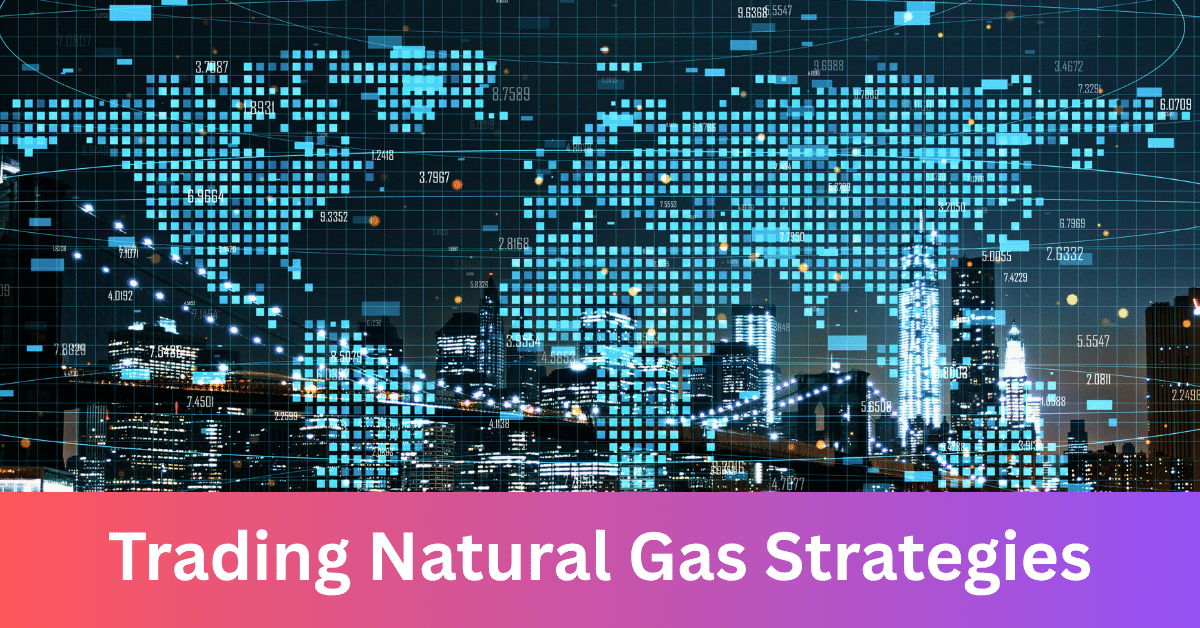Navigating the intricate world of natural gas trading can be a daunting endeavor for new market entrants, but with the right knowledge and strategies, it can also be a rewarding experience.
As the demand for natural gas continues to rise, understanding the dynamics of this volatile market becomes crucial for traders and investors seeking to maximize their returns.
This post will delve into essential trading strategies, providing a comprehensive natural gas market analysis that highlights key factors such as supply and demand, price volatility, and hedging techniques.
By exploring futures contracts and other proven methods, we aim to equip you with the tools necessary to confidently enter and succeed in the natural gas trading arena.
Join us as we uncover the insights needed to transform challenges into profitable opportunities in this dynamic sector.
NOTE: You can get your free Natural Gas Trading Strategies PDF guide below.
Table of Contents
Understanding Natural Gas Trading
To succeed in natural gas trading, it’s crucial to grasp the fundamental concepts, market dynamics, and factors influencing supply and demand. This section will provide a solid foundation for new market entrants.
Key Concepts and Definitions
Natural gas trading involves the buying and selling of natural gas as a commodity. It’s essential to understand the terminology and basic principles that govern this market.
Spot market refers to the immediate purchase and sale of natural gas for prompt delivery. In contrast, futures contracts involve agreements to buy or sell natural gas at a predetermined price on a future date.
Liquefied Natural Gas (LNG) is natural gas that has been cooled to a liquid state for ease of storage and transport. This form of natural gas plays a significant role in international trade.
The Henry Hub is a distribution hub in Louisiana that serves as the official delivery location for futures contracts on the New York Mercantile Exchange (NYMEX). It’s often used as a benchmark for North American natural gas prices.
Natural Gas Market Analysis
Conducting a thorough natural gas market analysis is crucial for making informed trading decisions. This process involves examining various factors that influence market conditions.
One key aspect of market analysis is monitoring production levels in major natural gas-producing regions. This includes tracking rig counts, well completions, and overall output from key players in the industry.
Another important factor is storage levels, which can significantly impact prices. The U.S. Energy Information Administration (EIA) releases weekly reports on natural gas storage, providing valuable insights for traders.
Geopolitical events, environmental regulations, and technological advancements in extraction methods also play crucial roles in shaping the natural gas market. Traders must stay informed about these developments to anticipate potential market shifts.
Role of Supply and Demand
The interplay between supply and demand is a fundamental driver of natural gas prices and trading opportunities. Understanding these dynamics is crucial for successful trading strategies.
On the supply side, factors such as production levels, pipeline capacity, and storage inventories play significant roles. Weather events like hurricanes can disrupt production, leading to supply constraints and potential price spikes.
Demand for natural gas is influenced by various sectors, including residential heating, industrial use, and power generation. Seasonal patterns, economic growth, and shifts in energy policies can all impact demand levels.
The balance between supply and demand creates price signals that traders use to make decisions. When demand outpaces supply, prices tend to rise, creating opportunities for traders with long positions. Conversely, oversupply situations can lead to price declines, benefiting those with short positions.
Developing Trading Strategies
Successful natural gas trading requires a well-thought-out strategy that combines fundamental analysis, technical analysis, and effective hedging techniques. This section explores these key components.
Fundamental Analysis Techniques
Fundamental analysis in natural gas trading involves evaluating the intrinsic value of natural gas based on economic, financial, and other qualitative and quantitative factors.
One crucial aspect of fundamental analysis is studying supply and demand dynamics. This includes monitoring production levels, storage data, and consumption patterns across various sectors such as residential, industrial, and power generation.
Economic indicators also play a significant role in fundamental analysis. Traders should keep an eye on GDP growth, industrial production indices, and employment data, as these can influence natural gas demand.
Weather forecasts are another critical component, especially for short-term trading. Extreme temperatures can lead to increased demand for heating or cooling, potentially impacting natural gas prices.
Geopolitical events and policy changes, such as shifts in environmental regulations or international trade agreements, can also significantly affect the natural gas market and should be factored into fundamental analysis.
Technical Analysis Methods
Technical analysis focuses on studying price movements and trading volumes to identify patterns and trends that can inform trading decisions.
Chart patterns are a key element of technical analysis. Common patterns include head and shoulders, double tops and bottoms, and triangles. These formations can signal potential price reversals or continuations.
Moving averages are widely used to smooth out price data and identify trends. Traders often look for crossovers between short-term and long-term moving averages as potential entry or exit signals.
Other popular technical indicators include the Relative Strength Index (RSI), which measures overbought or oversold conditions, and the Moving Average Convergence Divergence (MACD), which helps identify momentum shifts.
Volume analysis is also crucial in technical trading. Increased trading volume often confirms the strength of a price movement, while declining volume may signal a potential reversal.
Utilizing Hedging Techniques
Hedging is a risk management strategy that involves taking an offsetting position to protect against adverse price movements. It’s particularly important in the volatile natural gas market.
One common hedging technique is the use of futures contracts. Traders can take opposite positions in the futures market to offset potential losses in the spot market.
Options provide another hedging tool. Traders can buy put options to protect against downside risk or call options to limit potential losses on short positions.
Cross-commodity hedging is also possible, using correlated markets such as crude oil or electricity futures to manage natural gas price risk.
It’s important to note that while hedging can reduce risk, it may also limit potential profits. Traders must carefully balance their hedging strategies with their overall trading objectives.
Navigating Price Volatility
Price volatility is a defining characteristic of the natural gas market. Understanding how to navigate these fluctuations is crucial for successful trading.
Identifying Market Trends
Recognizing and analyzing market trends is essential for making informed trading decisions in the volatile natural gas market.
Long-term trends are often influenced by fundamental factors such as changes in production technology, shifts in energy policies, or evolving consumption patterns. These trends can persist for months or even years.
Short-term trends are typically driven by more immediate factors like weather patterns, storage reports, or sudden supply disruptions. These trends may last for days or weeks.
Traders use various tools to identify trends, including moving averages, trend lines, and momentum indicators. The key is to distinguish between genuine trends and temporary price fluctuations.
It’s also important to consider the context of price movements. For example, a price increase during the winter heating season may be part of a seasonal trend rather than the start of a long-term upward movement.
Risk Management Approaches
Effective risk management is crucial in the volatile natural gas market. Traders must implement strategies to protect their positions and capital.
One fundamental approach is position sizing. By limiting the size of individual trades relative to total capital, traders can reduce the impact of adverse price movements on their overall portfolio.
Stop-loss orders are another essential risk management tool. These orders automatically close out a position if the price reaches a predetermined level, limiting potential losses.
Diversification across different contract months or related energy commodities can also help manage risk. This strategy can reduce exposure to specific events or seasonal factors.
Regular monitoring and adjustment of positions is crucial. Market conditions can change rapidly, and traders must be prepared to modify their strategies accordingly.
Case Studies on Price Fluctuations
Examining historical price fluctuations can provide valuable insights for navigating future market volatility.
Case Study 1: Winter Storm Uri (February 2021)
-
Natural gas prices in Texas spiked from around $3/MMBtu to over $1,000/MMBtu
-
Caused by extreme cold weather and supply disruptions
-
Key takeaways:
-
Importance of weather forecasting in trading strategies
-
Need for robust risk management in extreme events
-
Potential for significant short-term price spikes in regional markets
-
Case Study 2: Price Collapse of 2020
-
Natural gas futures prices fell to multi-year lows, dropping below $2/MMBtu
-
Driven by oversupply and reduced demand due to mild weather and COVID-19 pandemic
-
Lessons learned:
-
Impact of global events on natural gas markets
-
Importance of monitoring storage levels and production data
-
Need for flexible trading strategies in changing market conditions
-
These case studies highlight the importance of staying informed about market-moving events and having strategies in place to manage both upside and downside risks.
Mastering Futures Contracts
Futures contracts are a cornerstone of natural gas trading, offering opportunities for both speculation and hedging. Understanding how to effectively use these instruments is crucial for success in the market.
Basics of Futures Trading
Natural gas futures contracts are standardized agreements to buy or sell a specific quantity of natural gas at a predetermined price on a future date.
The primary futures contract for natural gas in the U.S. is traded on the New York Mercantile Exchange (NYMEX). Each contract represents 10,000 million British thermal units (MMBtu) of natural gas.
Contract months typically extend out several years, with the nearest months being the most actively traded. The contract price is quoted in dollars and cents per MMBtu.
Understanding margin requirements is crucial when trading futures. Initial margin is the amount of money required to open a position, while maintenance margin is the minimum amount that must be maintained in the account.
It’s important to note that futures trading involves substantial risk and is not suitable for all investors. Traders should thoroughly understand the mechanics and risks before engaging in futures trading.
Strategies for Contract Management
Effective management of futures contracts is essential for maximizing profits and minimizing risks in natural gas trading.
One key strategy is rolling contracts. As contracts approach expiration, traders often “roll” their positions to a later month to maintain exposure to the market without taking physical delivery.
Spread trading involves simultaneously buying and selling contracts for different months. This strategy can be used to capitalize on price differences between contract months or to manage risk.
Traders should also consider liquidity when choosing which contracts to trade. The front-month contract (the nearest expiration) typically has the highest liquidity, making it easier to enter and exit positions.
Monitoring the term structure of futures prices (contango vs. backwardation) can provide insights into market expectations and inform trading decisions.
Examples of Successful Futures Trades
Examining real-world examples of successful futures trades can provide valuable insights for developing effective strategies.
Example 1: Seasonal Spread Trade
-
Strategy: Buy March contract and sell January contract
-
Rationale: Capitalize on typical price increase as winter progresses
-
Outcome: Profit from widening spread as March prices rise relative to January
Example 2: Weather-Based Trade
-
Strategy: Buy near-term contracts before forecasted cold snap
-
Rationale: Anticipate increased demand for heating
-
Outcome: Profit from price spike due to higher-than-expected natural gas consumption
These examples illustrate how traders can leverage their understanding of market dynamics and external factors to execute successful futures trades. However, it’s important to remember that past performance does not guarantee future results, and all trades carry risk.
Practical Application and Advice
Putting theory into practice is the ultimate test for any trader. This section provides actionable advice for implementing natural gas trading strategies effectively.
Building a Trading Plan
A well-structured trading plan is essential for consistent success in natural gas trading. It serves as a roadmap for your trading activities and helps maintain discipline.
Key components of a trading plan include:
-
Trading goals: Define clear, measurable objectives for your trading activities.
-
Risk tolerance: Determine the level of risk you’re comfortable with and set appropriate position sizes.
-
Entry and exit criteria: Establish specific conditions for opening and closing trades.
-
Risk management rules: Set stop-loss levels and define how you’ll manage losing positions.
Your trading plan should also include a strategy for continuous improvement. Regularly review and analyze your trades to identify areas for refinement.
Remember, a trading plan is a living document. Be prepared to adjust it as market conditions change or as you gain more experience and insights.
Tools and Resources for Traders
Successful natural gas trading requires access to reliable data and effective analytical tools. Here are some essential resources:
-
Market data providers: Platforms like Bloomberg, Reuters, or specialized energy data services offer real-time price data, news, and analysis.
-
Charting software: Tools such as TradingView or MetaTrader provide advanced charting capabilities for technical analysis.
-
Fundamental data sources: The U.S. Energy Information Administration (EIA) provides crucial data on production, consumption, and storage levels.
-
Weather forecasting services: Given the impact of weather on natural gas demand, access to accurate forecasts is crucial.
-
Risk management software: Tools for portfolio analysis and risk assessment can help manage complex trading positions.
It’s important to choose tools that align with your trading style and strategy. Many providers offer free trials, allowing you to test different options before committing.
Continuous Learning and Market Updates
The natural gas market is dynamic, with new developments constantly shaping trading conditions. Continuous learning is essential for staying competitive.
Stay informed about market news and trends through:
-
Industry publications and newsletters
-
Webinars and online courses
-
Energy conferences and seminars
Network with other traders to share insights and discuss market developments. Online forums and social media groups can be valuable resources for connecting with peers.
Regularly review and update your knowledge of:
-
Regulatory changes affecting the natural gas industry
-
Technological advancements in production and distribution
-
Shifts in global energy policies and their potential impact on natural gas markets
Remember, successful trading is as much about adapting to changing market conditions as it is about executing strategies. Stay curious, remain flexible, and always be ready to learn and evolve your approach.


